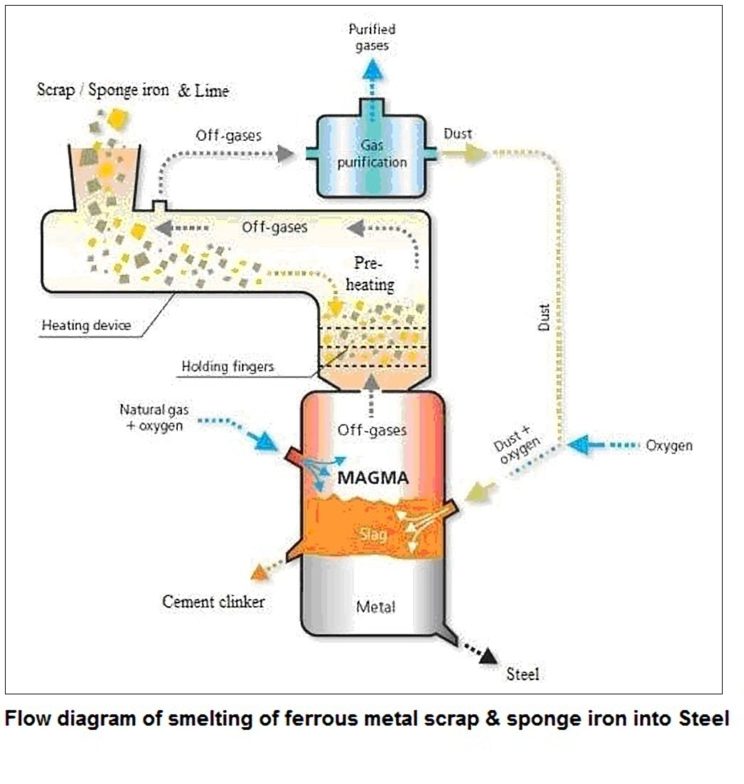Oxygen-melting of metal scrap and sponge iron in MAGMA
Scrap and slag-forming materials are smelted in a liquid bath of molten metal formed upon starting the smelting unit MAGMA.
For refining of the molten metal from phosphorus and partially from sulphur, oxidized basic slag (slag ratio 0.05-0.06) is put over the molten metal which is, from time to time, renewed.
The heat required for metal heating and smelting is fed into the working space of the smelting chamber by fuel-oxygen or oxygen burner and by oxidation of coal by gaseous oxygen fed into the bath by special lances.
Temperature of molten slag is 1,600-1,650°С and the temperature of metal is 1,500-1,580°С.
The generated metal semi-product is non-continuously released from the smelting chamber into the ladle and transported further to the heating facility of the ladle-furnace unit.
Processed slag is released from the smelting chamber non- continuously. At a later stage, it can be used for production of Portland cement clinker.
Production capacity of the standard model of MAGMA for scrap reaches 50-55 tons per hour.
The smelting unit can also operate with extra-furnace heating of scrap by off-gases. Above the smelting chamber, a hermetically sealed shaft heater of scrap, in this case, is installed.The shaft heater is being equipped with holding and dozing devices and lances for after burning of CO in the off-gases.
Production capacity of MAGMA in this case increases up to 65 tons per hour.
Use of MAGMA for continuous smelting of ferrous metals’ scrap and production of metal semi-product allows to significantly reducing the aggregate consumption of fuel as compared with conventional arc steel furnaces, due to more rational use of the energy of primary fuel.
The proposed technology of scrap processing has a number of technical and economic advantages over the conventional, combination process used in electric-smelting of steel: steel electric arc furnace and ladle- furnace unit.
First of all, this means an increase of output of proper liquid metal in smelting. While the conventional smelting of scrap in an arc furnace with the use of smelting intensifiers provides an output of proper product in the range of 91-92%, the proposed technology provides an output of proper product after scrap smelting in the range of 94-95%.
Increase of output of the proper product is achieved through:
- Lesser oxidation of iron when smelting in a liquid bath (immersion of a piece of scrap into the molten mass);
- Lesser development of iron oxidation in the presence of coal carbon;
- Recuperation of iron-containing dust captured by the gas treatment system by injectors to the molten slag;
- Small losses of iron in the form of prills in cast slag due to the use of small volume of slag in the process of re-smelting of scrap and application of original siphon design of release of slag from MAGMA;
- Exclusion of slag pumping from MAGMA due to application of a tap hole for metal equipped with a siphon channel.
The proposed technology of smelting of ferrous scrap, as compared with the technology conventionally used, decreases capital costs because of absence of heavy-duty electric arc furnace and respective costly power infrastructure for its operation.

